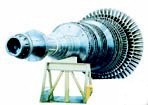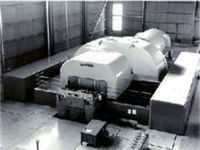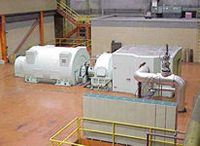 |
A steam turbine is a collection of circular fan blades
(just like a domestic fan) all attached to one rotor, inside a cylindrical
casing. Steam is fed into one end, and as it expands, it pushes against
the blades, causing them (and the rotor to which they are attached) to
spin. |
A steam turbine can generate a lot of power relative to its
size. For this reason, it has become the primary source of power for electricity
generation and for large ships, tankers and barges.
 |
 |
History – Steam Engines
Steam engines were the first practical devices developed
for the conversion of heat into mechanical power. In 1679, French physicist
Denis Papin was developing a kind of pressure cooker, when he noticed that
the steam was raising the lid on the pot. From this he developed the idea
of using the steam to power a piston inside a cylinder. In 1712, English inventor
Thomas Savery and Thomas Newcomen built the first piston-operated steam pump.
Even though this kind of engine only converted about 1% of the available energy
in the steam into mechanical energy, they remained unrivaled for over 50 years.
In 1765, James Watt and Matthew Boulton made some significant improvements
on earlier designs, the most important of which was the addition of a shaft
and gears that enabled a rotary motion (instead of just an up and down motion).
Still, they were only able to reach an efficiency of about 2%. Over the next
150 years, a number of others made various improvements, and by 1900 steam
engine efficiency had climbed to about 17%.
Stirling Engines
Many of the early high pressure steam boilers that generated
the steam for these engines, exploded because of bad materials and designs.
In 1816, Robert Stirling patented a low pressure engine that did not require
a high pressure boiler. Air is heated by external combustion through a heat
exchanger and then is displaced, compressed, and expanded by two pistons.
These engines are efficient, safer, quieter, produce less pollution, and can
burn almost any fuel. However, they are more expensive, and because of this
they have never really caught on.
Modern Steam Turbines
The steam turbines used today for power production are
similar in design to early models, however they use much more sophisticated
materials, designs and controls. Efficiencies have improved to almost 40%.
Let's take a look at some of the factors that we consider
when designing a Steam Turbine system.
|